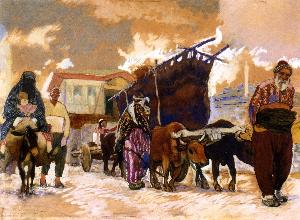Evgeny Yevgenyevich Lanceray
Evgeny Yevgenyevich Lanceray;Eugene Lanceray
Place: Pavlovsk
Born: 1875
Death: 1946
Biography:
Eugene Lanceray was a Russian graphic artist, painter, sculptor, mosaicist, and illustrator, associated stylistically with Mir iskusstva ('World of Art'). He was born in Pavlovsk, Russia, a suburb of Saint Petersburg, and came from a prominent Russian artistic family of French origin. His father, Eugeny Alexandrovich Lanceray, was a sculptor. His grandfather Nicholas Benois, and his uncle Leon Benois, were celebrated architects. Another uncle, Alexandre Benois, was a respected artist, art critic, historian and preservationist. His great-grandfather was Venetian-born Russian composer Catterino Cavos. Lanceray's siblings were also heirs to this artistic tradition. His sister, Zinaida Serebriakova, was a painter, while his brother Nikolay was an architect. His cousin, Nadia Benois, was mother of Peter Ustinov. Lanceray took his first lessons at the Drawing School of the Imperial Society for the Encouragement of the Arts in St. Petersburg from 1892 to 1896. under Jan Ciągliński and Ernst Friedrich von Liphart. He then traveled to Paris, where he continued his studies at the Académie Colarossi and Académie Julian between 1896 and 1899. After returning from France to Russia, Lanceray joined Mir iskusstva, an influential Russian art movement inspired by an artistic journal of the same name, founded in 1899, in Saint Petersburg. He was younger than the masters of Mir iskusstva and initially acted as their student. His creative method and aesthetic views evolved under the influence and guidance of Benois, although, by some aspects of his talent, Lanceray may have exceeded his teacher. His first significant works in the field of easel painting and graphics were created in the late 1890 - early 1900s. The main creative interests of the artist were turned at that time to the 'historical', mainly architectural landscape. Lanceray's most celebrated mural painting is located at the ceiling of Moscow Kazansky railway station (1933-1934). Besides its place and its scale, the distinctive feature of this work is that it was made using tempera paint, so beloved by the artist. But he worked with various media, and the area of his activity included not only mural art but also fine art, graphics, illustration and theatrical scenery. For the first time, Lanceray took to the work in the theater in early 1900s, paying tribute to the passion for theater painting, which was characteristic of almost all the representatives of the older generation of the Mir iskusstva group. Lanceray was the only prominent member of Mir iskusstva who remained in Russia after the revolution. He continued to work in the Soviet Union and became one of the leading masters of monumental painting. He died in Moscow in 1946.



